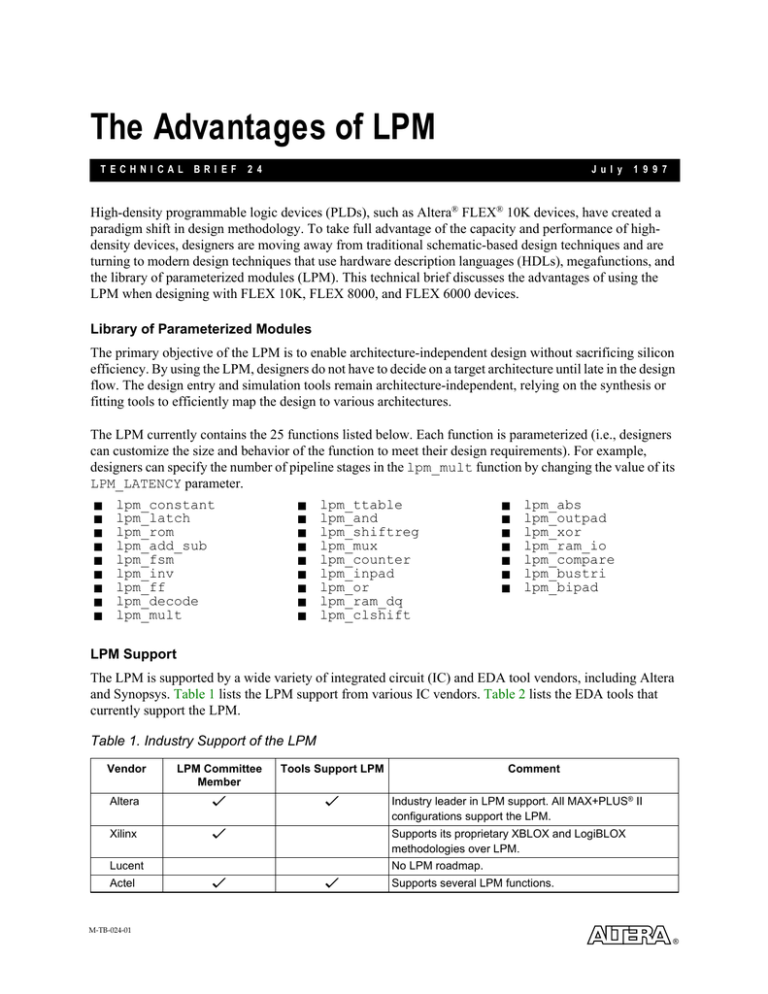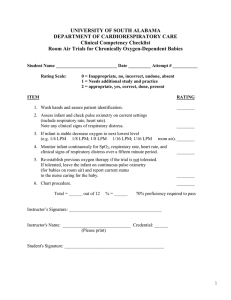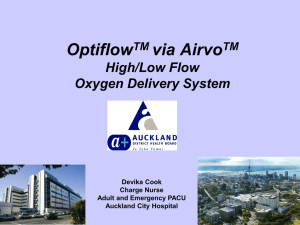
The Advantages of LPM
TECHNI C AL
BR I E F
2 4
Ju ly
1 997
High-density programmable logic devices (PLDs), such as Altera® FLEX® 10K devices, have created a
paradigm shift in design methodology. To take full advantage of the capacity and performance of highdensity devices, designers are moving away from traditional schematic-based design techniques and are
turning to modern design techniques that use hardware description languages (HDLs), megafunctions, and
the library of parameterized modules (LPM). This technical brief discusses the advantages of using the
LPM when designing with FLEX 10K, FLEX 8000, and FLEX 6000 devices.
Library of Parameterized Modules
The primary objective of the LPM is to enable architecture-independent design without sacrificing silicon
efficiency. By using the LPM, designers do not have to decide on a target architecture until late in the design
flow. The design entry and simulation tools remain architecture-independent, relying on the synthesis or
fitting tools to efficiently map the design to various architectures.
The LPM currently contains the 25 functions listed below. Each function is parameterized (i.e., designers
can customize the size and behavior of the function to meet their design requirements). For example,
designers can specify the number of pipeline stages in the lpm_mult function by changing the value of its
LPM_LATENCY parameter.
■
■
■
■
■
■
■
■
■
lpm_constant
lpm_latch
lpm_rom
lpm_add_sub
lpm_fsm
lpm_inv
lpm_ff
lpm_decode
lpm_mult
■
■
■
■
■
■
■
■
■
lpm_ttable
lpm_and
lpm_shiftreg
lpm_mux
lpm_counter
lpm_inpad
lpm_or
lpm_ram_dq
lpm_clshift
■
■
■
■
■
■
■
lpm_abs
lpm_outpad
lpm_xor
lpm_ram_io
lpm_compare
lpm_bustri
lpm_bipad
LPM Support
The LPM is supported by a wide variety of integrated circuit (IC) and EDA tool vendors, including Altera
and Synopsys. Table 1 lists the LPM support from various IC vendors. Table 2 lists the EDA tools that
currently support the LPM.
Table 1. Industry Support of the LPM
Vendor
LPM Committee
Member
Tools Support LPM
Altera
v
v
Xilinx
v
Industry leader in LPM support. All MAX+PLUS® II
configurations support the LPM.
Supports its proprietary XBLOX and LogiBLOX
methodologies over LPM.
Lucent
Actel
Comment
No LPM roadmap.
v
v
Supports several LPM functions.
M-TB-024-01
®
ALTERA MEGAFUNCTION PARTNERS PROGRAM
Table 2. EDA Tools that Support the LPM
Tool Description
Cadence
Mentor Graphics
Synopsys
ViewLogic
Note (1)
Note (1)
Behavioral Simulator
Leapfrog
QuickHDL
Synthesis
Synergy
Exemplar, Galileo
Gate Level Simulator
Verilog XL
QuickSim II
Note (1)
ViewSim
Schematic Capture
Concert
Design Architect
Note (1)
ViewDraw
ViewSynthesis
FPGA Express
Note:
(1)
The vendor does not currently offer products that support this function.
Altera provides substantial support for the LPM by serving as a member on the Electronic Industries
Association’s (EIA) LPM committee and providing tools that support the LPM. Altera’s MAX+PLUS II
development system supports all LPM functions, except lpm_fsm, lpm_ttable, lpm_inpad,
lpm_outpad, and lpm_bipad.
LPM functions take maximum advantage of the FLEX architecture, which enables LPM functions to
achieve high performance in FLEX devices. For example, a multiplier function implemented in a FLEX
device out-performs a multiplier function implemented in competing devices, as shown in Table 3.
Multiplier performance is critical because it is a basic building block of most DSP systems and it impacts
system performance.
Table 3. Multiplier Comparison
Logic
Performance (MHz)
Altera
FLEX 10K (1)
-3 Speed
Grade
Altera
Altera
FLEX 8000 (1) FLEX 6000 (1)
-2 Speed
-2 Speed
Grade
Grade
Xilinx
XC4000E
-2 Speed
Grade
Lucent
OR2C15A (2)
-4 Speed
Grade
Actel
1200XL (3)
-1 Speed
Grade
8 × 8 multiplier
pipelined
131
132
114
52, Note (4)
96
44
8 × 8 multiplier
non-pipelined
37
44
38
29, Note (5)
24
14
12 × 12 multiplier
pipelined
80
81
78
38, Note (4)
Note (6)
Note (6)
12 × 12 multiplier
non-pipelined
21
22
22
21, Note (5)
Note (6)
Note (6)
16 × 16 multiplier
pipelined
53
69
59
Note (6)
55
28
16 × 16 multiplier
non-pipelined
19
21
20
18, Note (5)
7
8
32 × 32 multiplier
pipelined
28
–
–
Note (6)
Note (6)
Note (6)
Notes:
(1)
(2)
(3)
(4)
(5)
(6)
Source: Altera Applications. Altera’s multipliers have a 4-stage pipeline, except the 8 × 8 multiplier, which has a 3-stage pipeline.
Sources: Synario App Review, September 9, 1996, page 11. Lucent Microelectronics Field-Programmable Gate Array Data Book, October
1996. Lucent’s multipliers use various levels of pipelining, including 3-, 6-, and 9-stage pipelines.
Source: Actel Application Note Implementing Multipliers in Actel FPGAs. Actel’s multiplier uses a 3-stage pipeline.
Source: Synario App Review, September 9, 1996, page 20.
Sources: Synario App Review, September 9, 1996, page 20. Xilinx The Programmable Logic Data Book, September 1996. The performance
value was obtained by adding the setup time, clock-to-output time, routing delay, and then inverting it to obtain the frequency. Xilinx’s
multipliers have a 4-stage pipeline.
No data is currently available.
Altera Corporation
2
Using the LPM and the MAX+PLUS II development system, designers can automatically create a
multiplier of any size in minutes. For maximum performance, designers can use the LPM_LATENCY
parameter (e.g., LPM_LATENCY = 2) to create a pipelined multiplier that is optimized for the FLEX
architecture, utilizing the carry chains. Furthermore, the speed and efficiency of the LPM enables designers
to quickly test various pipeline lengths to optimize an application for speed and logic efficiency. Figure 1
shows the dialog box for the lpm_mult function in the MAX+PLUS II software.
Figure 1. lpm_mult Dialog Box
In contrast, competing vendors provide significantly less, if any, support for the LPM. For example, rather
than supporting the LPM, Xilinx supports its proprietary XBLOX and LogiBLOX methodologies, which
are graphical interface tools for creating and simulating high-level functions. The XBLOX methodology
does not support signed multipliers, and the LogiBLOX methodology does not support multipliers, which
are vital for digital signal processing (DSP) applications.
The following document provides more detailed information. The part number is in parenthesis.
■
LPM Quick Reference Guide (A-CAT-LPM-01)
You can request this document from:
■
■
■
Altera Literature Services at (888) 3-ALTERA
World-wide web site at http://www.altera.com
Your local Altera sales representative
Copyright 1997 Altera Corporation. Altera, MAX, MAX+PLUS, MAX+PLUS II, FLEX, FLEX 10K, FLEX 8000, and FLEX 6000 are trademarks
and/or service marks of Altera Corporation in the United States and/or other countries. Other brands or products are trademarks of their
respective holders. All rights reserved.
3
®
Altera Corporation




